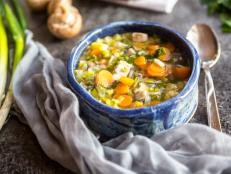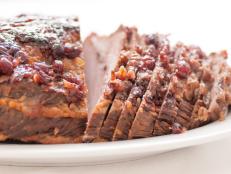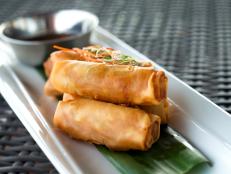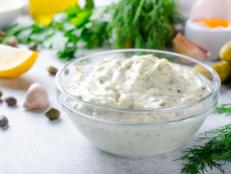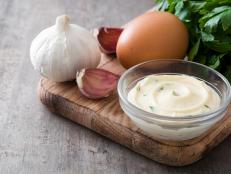What Is Baklava?
Learn all about this flaky, sweet, layered pastry and how to make it.

Natasha Breen/Getty Images
By Layla Khoury-Hanold for Food Network Kitchen
Layla Khoury-Hanold is a contributor at Food Network.
You may know baklava as a quintessential Middle Eastern pastry or have seen it listed on the dessert menu at Greek, Turkish or Lebanese restaurants. But what exactly is baklava? For more info, we consulted Tarik Fallous, chef-owner of Au Za’atar restaurant in New York City.

NicolasMcComber/Getty Images
What Is Baklava?
Baklava is a sweet, flaky pastry made with layers of phyllo dough, filled with chopped nuts and soaked in syrup or honey.
Baklava is a popular and traditional dessert in in the Middle East and parts of the Mediterranean.“Baklava, also known as baklawa or baklawa, holds special significance and is often served during festive occasions such as weddings, gatherings, graduation parties, promotions and even until recently, when visiting someone recovering in the hospital, we would take a tray of baklawa,” Fallous says.
He notes that many people in these communities have their favorite pastry shop and preferred baklava iterations. “Many baklawa masters are third or fourth generation and there are some pastry shops that have been around for 100 years. There are places that I’ve had baklawa in my childhood, and it still tastes the same.”

resulmuslu/Getty Images
Different Types of Baklava
Baklava can be made with all sorts of ingredients depending on regional and personal preferences, Fallous explains. Three common types are Greek, Turkish and Lebanese baklava.
Greek Baklava
Greek baklava often calls for walnuts as the primary nut filling and is typically seasoned with ground cinnamon. The syrup used in Greek baklava generally includes honey in addition to sugar and water, which gives Greek baklava its distinct glossy finish. Typically, Greek baklava is cut into large triangles.
Turkish Baklava
Turkish baklava is typically made with a pistachio based filling and is usually cut into square or diamond shaped pieces.
Lebanese Baklava
Lebanese baklava can be made with a variety of nuts, including walnuts, pistachios, cashews or almonds. Typically, the syrup is not as sweet as in Greek or Turkish baklava syrups. The syrup is often perfumed with rose water or orange blossom water, as well as lemon juice, which also helps thicken it. Lebanese baklava pieces tend to be smaller in size than in other regions and the pieces also vary in shape, including squares, diamonds, triangles or cylinders.

Kuzihar/Getty Images
Ingredients In Baklava
Fallous outlines a list of common ingredients used to make baklava.
Phyllo (or Filo) Dough: Thin sheets of unleavened pastry dough.
Nuts: Chopped nuts, typically walnuts, pistachios, almonds or cashews.
Butter or Oil: Melted butter or vegetable oil, used to brush the layers of phyllo dough.
Sugar: Added to the nut mixture and the sweet syrup.
Spices: Optional ground spices include cinnamon, clove or cardamom for flavoring the nut mixture.
Syrup: A sweet syrup made from sugar, water and sometimes lemon juice, rose water or orange blossom water. In some variations, honey may also be used in the syrup.

igor_kell/Getty Images
How to Make Baklava
Step one: Preheat the oven. Preheat the oven to 350 degrees F.
Step two: Prep the ingredients. Chop nuts such as walnuts, pistachios, almonds or cashews. Melt butter if using (alternatively, vegetable oil may be used). Make a sweet syrup by boiling together sugar and water, and add lemon juice, rose water, orange blossom water or honey, depending on your preference. Allow syrup to cool.
Step three: Make the filling. Mix the nuts of your choice with syrup and additional spices, such as ground cinnamon, cloves or cardamom, if desired.
Step four: Layer phyllo and filling. Stack layers of phyllo dough sheets in a baking pan, brushing each sheet with melted butter or vegetable oil. Add the filling and then add more layers of phyllo, each brushed with melted butter or vegetable oil.
Step five: Cut the baklava. Cut baklava into individual pieces in your desired shape, such as squares, rectangles, triangles or diamonds.
Step six: Bake the baklava. Bake until golden brown, about 40 to 45 minutes.
Step seven: Add the syrup. Slowly pour the cooled syrup over hot baklava to evenly soak. Let baklava rest before serving.

dogayusufdokdok/Getty Images
How to Store Baklava
Proper storage is important to maintain both the freshness and flavor of baklava. Fallous outlines three different ways to store baklava and offers tips for thawing after storing baklava in the refrigerator or freezer.
How to Store Baklava at Room Temperature
Baklava can be stored at room temperature in an airtight container or tightly covered with plastic wrap or aluminum foil. Keep it in a cool, dry place away from direct sunlight, as heat and humidity can affect its texture and freshness. At room temperature, baklava can typically stay fresh for up to one to two weeks, depending on factors like humidity and the specific ingredients used.
How to Store Baklava in the Refrigerator
Baklava is traditionally stored at room temperature, but you can also store it in the refrigerator. Place baklava in an airtight container or wrap it tightly with plastic wrap or foil to prevent moisture absorption and maintain freshness. When stored in the refrigerator, baklava can last two to four weeks.
How to Store Baklava in the Freezer
For long-term storage, store baklava in the freezer. Wrap individual pieces or the entire tray in plastic wrap and then in aluminum foil. Alternatively, you can store baklava in an airtight container or freezer-safe bag. Be sure to label and date the package. Baklava can last for up to six months stored in the freezer.
How to Thaw Baklava
To enjoy baklava after refrigeration or freezing, let it come to room temperature for the best texture and flavor. Avoid frequent temperature fluctuations, as they can lead to moisture condensation and affect the crispiness of the pastry.
Baklava Recipes
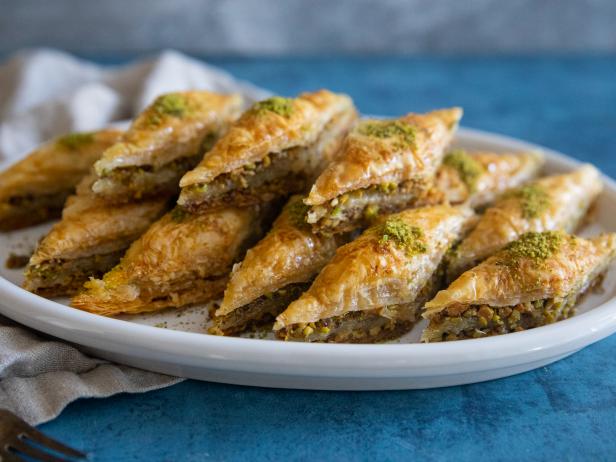
This baklava recipe is based on the pistachio baklava common in Turkey, though you can also find other varieties there such as walnut, cream-filled or chocolate at shops known as baklavacı. Be sure to pour the cooled syrup over hot baklava to ensure a perfectly crisp texture.

This baklava recipe was created as an homage to the delicious combination of apples and honey, so the syrup is honey-forward and the filling has less nuts to allow the apples to take center stage. Breadcrumbs between the bottom layers of the phyllo dough help to absorb excess moisture from the apples and keep it crisp.

This unconventional baklava recipe calls for a filling made with rum-soaked dried figs, a mixture of toasted walnuts and almonds, chocolate and a trio of warming spices including ground cinnamon, clove and cardamom. It all adds up to an exceptionally rich dessert that just might be your new favorite baklava combination.

Con Poulos Prop Stylist: Marina Malchin 917 751 2855
This riff on classic pistachio baklava is much less labor intensive, thanks to the use of mini phyllo shells instead of layered phyllo dough sheets. It’s also much quicker—they bake up in 10 minutes and make an ideal dessert for a dinner party or weekend treat.

Ryan Liebe, Ryan K Liebe
Choose from a variety of nuts or a mix of several for the filling in this baklava recipe, including hazelnuts, walnuts, pistachios or almonds. For the syrup, rose water adds a floral aroma while the addition of lemon adds a little zing and helps thicken the syrup.
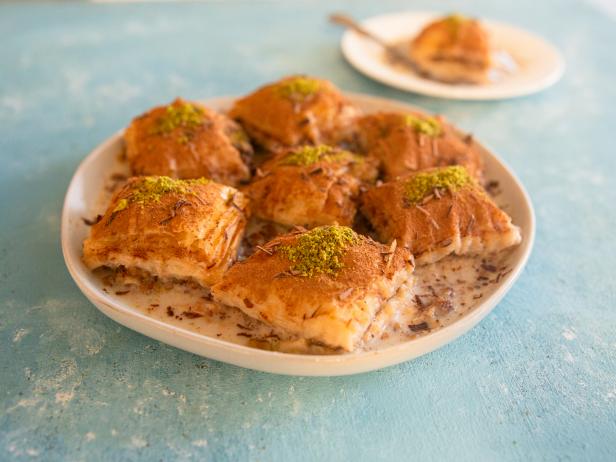
In Turkey, cold baklava, called sutlu soğuk baklava, has become a popular confection in recent years, especially during summertime and Ramadan. This version is soaked in a combination of milk and syrup, which gives it a softer texture compared to traditional crisp baklava.
Related Links:

























